Abstract
Purpose
The aim of this study was to investigate whether the application of nano-structured alumina coating to the surface of Y-TZP could enhance the bond strength with resin cement.
Materials and methods
A total of 80 zirconia plates were prepared and divided into four groups. : 1) airborne particle abrasion treatment (A) : 2) Rocatec treatment after airborne particle abrasion (R) : 3) nano-structured alumina coating treatment after polishing (PC) and 4) nano-structured alumina coating after airborne particle abrasion (AC). Alumina coating was formed by the hydrolysis of aluminium nitride (AlN) powder and heat treatment at 900。 C. Coating patterns were observed with FE-SEM. Resin block was bonded to treated zirconia ceramics using resin cement. The shear bond strengths were measured before and after thermocycling.
Results
The FE-SEM images show a dense and uniform nano-structured alumina coating structure, which enhances shear bond strength by increasing micro mechanical interlocking to resin cement. PC and AC groups showed higher shear bond strengths than A and R groups before and after thermocycling. A and R groups displayed significant drops in shear bond strength after thermocycling. However, PC and AC groups did not show any meaningful decreases in shear bond strength after thermocycling.
Go to : 
REFERENCES
1.Anusavice KJ. Recent developments in restorative dental ceramics. J Am Dent Assoc. 1993. 124:72–4. 76-8, 80-4.

4.Jevnikar P., Krnel K., Kocjan A., Funduk N., Kosmac T. The effect of nano-structured alumina coating on resin-bond strength to zirconia ceramics. Dent Mater. 2010. 26:688–96.

5.Denry I., Kelly JR. State of the art of zirconia for dental applications. Dent Mater. 2008. 24:299–307.

6.Della Bona A., Anusavice KJ., Shen C. Microtensile strength of composite bonded to hot-pressed ceramics. J Adhes Dent. 2000. 2:305–13.
7.Della Bona A., Anusavice KJ. Microstructure, composition, and etching topography of dental ceramics. Int J Prosthodont. 2002. 15:159–67.
8.Brentel AS., Ozcan M., Valandro LF., Alarça LG., Amaral R., Bottino MA. Microtensile bond strength of a resin cement to feldpathic ceramic after different etching and silanization regimens in dry and aged conditions. Dent Mater. 2007. 23:1323–31.

9.Ozcan M., Vallittu PK. Effect of surface conditioning methods on the bond strength of luting cement to ceramics. Dent Mater. 2003. 19:725–31.
10.Dérand P., Dérand T. Bond strength of luting cements to zirconium oxide ceramics. Int J Prosthodont. 2000. 13:131–5.
11.Aboushelib MN., Matinlinna JP., Salameh Z., Ounsi H. Innovations in bonding to zirconia-based materials: Part I. Dent Mater. 2008. 24:1268–72.

12.Aboushelib MN., Mirmohamadi H., Matinlinna JP., Kukk E., Ounsi HF., Salameh Z. Innovations in bonding to zirconia-based materials. Part II: Focusing on chemical interactions. Dent Mater. 2009. 25:989–93.

13.Blatz MB., Sadan A., Kern M. Resin-ceramic bonding: a review of the literature. J Prosthet Dent. 2003. 89:268–74.

14.Ozcan M., Kerkdijk S., Valandro LF. Comparison of resin cement adhesion to Y-TZP ceramic following manufacturers' instructions of the cements only. Clin Oral Investig. 2008. 12:279–82.
15.Amaral R., Ozcan M., Bottino MA., Valandro LF. Microtensile bond strength of a resin cement to glass infiltrated zirconia-reinforced ceramic: the effect of surface conditioning. Dent Mater. 2006. 22:283–90.

16.Heikkinen TT., Lassila LV., Matinlinna JP., Vallittu PK. Effect of operating air pressure on tribochemical silica-coating. Acta Odontol Scand. 2007. 65:241–8.

17.Ozcan M. Evaluation of alternative intra-oral repair techniques for fractured ceramic-fused-to-metal restorations. J Oral Rehabil. 2003. 30:194–203.
18.Valandro LF., Ozcan M., Bottino MC., Bottino MA., Scotti R., Bona AD. Bond strength of a resin cement to high-alumina and zirconia-reinforced ceramics: the effect of surface conditioning. J Adhes Dent. 2006. 8:175–81.
19.Xible AA., de Jesus Tavarez RR., de Araujo Cdos R., Bonachela WC. Effect of silica coating and silanization on flexural and composite-resin bond strengths of zirconia posts: An in vitro study. J Prosthet Dent. 2006. 95:224–9.

20.Bottino MA., Valandro LF., Scotti R., Buso L. Effect of surface treatments on the resin bond to zirconium-based ceramic. Int J Prosthodont. 2005. 18:60–5.

21.Ural C., Külünk T., Külünk S., Kurt M., Baba S. Determination of resin bond strength to zirconia ceramic surface using different primers. Acta Odontol Scand. 2011. 69:48–53.

22.Mirmohammadi H., Aboushelib MN., Salameh Z., Feilzer AJ., Kleverlaan CJ. Innovations in bonding to zirconia based ceramics: Part III. Phosphate monomer resin cements. Dent Mater. 2010. 26:786–92.

23.Wegner SM., Gerdes W., Kern M. Effect of different artificial aging conditions on ceramic-composite bond strength. Int J Prosthodont. 2002. 15:267–72.
24.Akgungor G., Sen D., Aydin M. Influence of different surface treatments on the short-term bond strength and durability between a zirconia post and a composite resin core material. J Prosthet Dent. 2008. 99:388–99.

25.Novak S., Kosmac T. Preparation of alumina ceramics from aqueous suspensions employing the hydrolysis of aluminum nitride. J Mater Res. 2002. 17:445–50.

26.Krnel K., Kocjan A., Kosmac T. A simple method for the preparation of nanostructured aluminate coatings. J Am Ceram Soc. 2009. 92:2451–4.

27.Zhang S., Kocjan A., Lehmann F., Kosmac T., Kern M. Influence of contamination on resin bond strength to nano-structured alumina-coated zirconia ceramic. Eur J Oral Sci. 2010. 118:396–403.

28.Lindgren J., Smeds J., Sjögren G. Effect of surface treatments and aging in water on bond strength to zirconia. Oper Dent. 2008. 33:675–81.

29.Wolfart M., Lehmann F., Wolfart S., Kern M. Durability of the resin bond strength to zirconia ceramic after using different surface conditioning methods. Dent Mater. 2007. 23:45–50.
30.Kern M., Wegner SM. Bonding to zirconia ceramic: adhesion methods and their durability. Dent Mater. 1998. 14:64–71.

31.Phark JH1., Duarte S Jr., Blatz M., Sadan A. An in vitro evaluation of the long-term resin bond to a new densely sintered high-purity zirconium-oxide ceramic surface. J Prosthet Dent. 2009. 101:29–38.

32.Blatz MB., Chiche G., Holst S., Sadan A. Influence of surface treatment and simulated aging on bond strengths of luting agents to zirconia. Quintessence Int. 2007. 38:745–53.
33.Amaral R1., Ozcan M., Valandro LF., Balducci I., Bottino MA. Effect of conditioning methods on the microtensile bond strength of phosphate monomer-based cement on zirconia ceramic in dry and aged conditions. J Biomed Mater Res B Appl Biomater. 2008. 85:1–9.

34.O¨zcan M., Nijhuis H., Valandro LF. Effect of various surface conditioning methods on the adhesion of dual-cure resin cement with MDP functional monomer to zirconia after thermal aging. Dent Mater J. 2008. 27:99–104.
35.Ernst CP., Cohnen U., Stender E., Willershausen B. In vitro retentive strength of zirconium oxide ceramic crowns using different luting agents. J Prosthet Dent. 2005. 93:551–8.

36.Matinlinna JP., Heikkinen T., Ozcan M., Lassila LV., Vallittu PK. Evaluation of resin adhesion to zirconia ceramic using some organosilanes. Dent Mater. 2006. 22:824–31.

37.Lüthy H., Loeffel O., Hammerle CH. Effect of thermocycling on bond strength of luting cements to zirconia ceramic. Dent Mater. 2006. 22:195–200.
38.Breschi L., Mazzoni A., Ruggeri A., Cadenaro M., Di Lenarda R., De Stefano Dorigo E. Dental adhesion review: aging and stability of the bonded interface. Dent Mater. 2008. 24:90–101.

39.Yang B., Barloi A., Kern M. Influence of air-abrasion on zirconia ceramic bonding using an adhesive composite resin. Dent Mater. 2010. 26:44–50.

40.Kosmac T., Oblak C., Jevnikar P., Funduk N., Marion L. The effect of surface grinding and sandblasting on flexural strength and reliability of Y-TZP zirconia ceramic. Dent Mater. 1999. 15:426–33.
41.Kosmac T., Oblak C., Jevnikar P., Funduk N., Marion L. Strength and reliability of surface treated Y-TZP dental ceramics. J Biomed Mater Res. 2000. 53:304–13.
42.Zhang Y1., Lawn BR., Malament KA., Van Thompson P., Rekow ED. Damage accumulation and fatigue life of particle-abraded ceramics. Int J Prosthodont. 2006. 19:442–8.
Go to : 
 | Fig. 1.(A) FE-SEM image (×5,000) demonstrating polished Y-TZP surface, (B) FE-SEM image (×5,000) demonstrating airborne particle abraded Y-TZP surface, (C) FE-SEM image (×5,000) demonstrating tribochemical coating treated Y-TZP surface. |
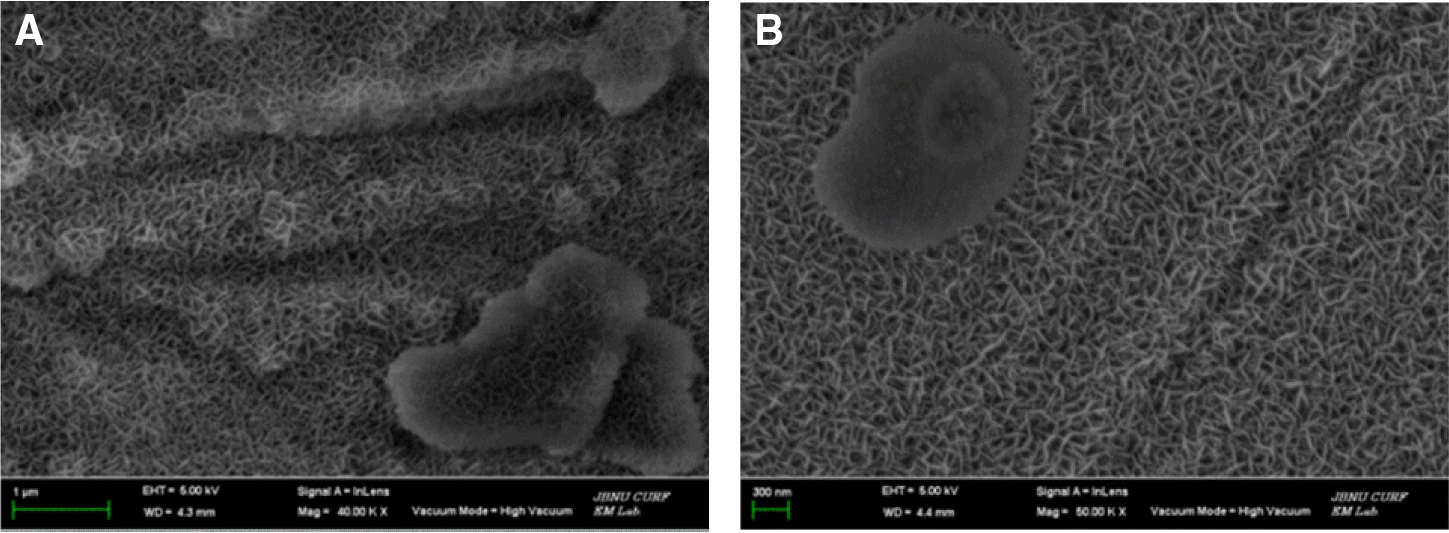 | Fig. 2.(A) FE-SEM image (×50,000) demonstrating the large retentive surface architecture created after completion of nano-structured alumina coating on polished Y-TZP surface, (B) FE-SEM image (×50,000) demonstrating the large retentive surface architecture created after completion of nano-structured alumina coating on air abraded Y-TZP surface. |
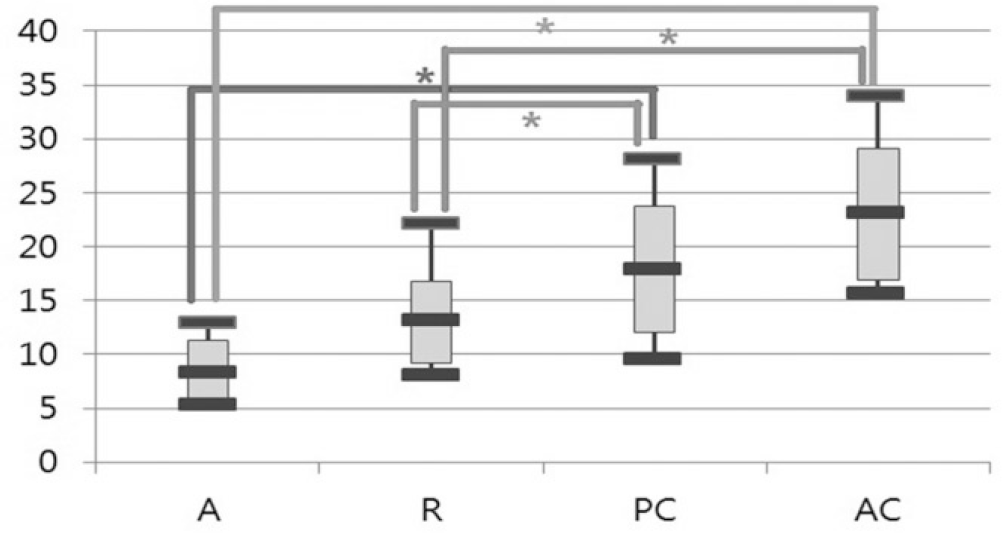 | Fig. 3.Shear-bond strength before thermocycling. The bars represent the SDs. ∗ indicates significant difference (P<.05). |
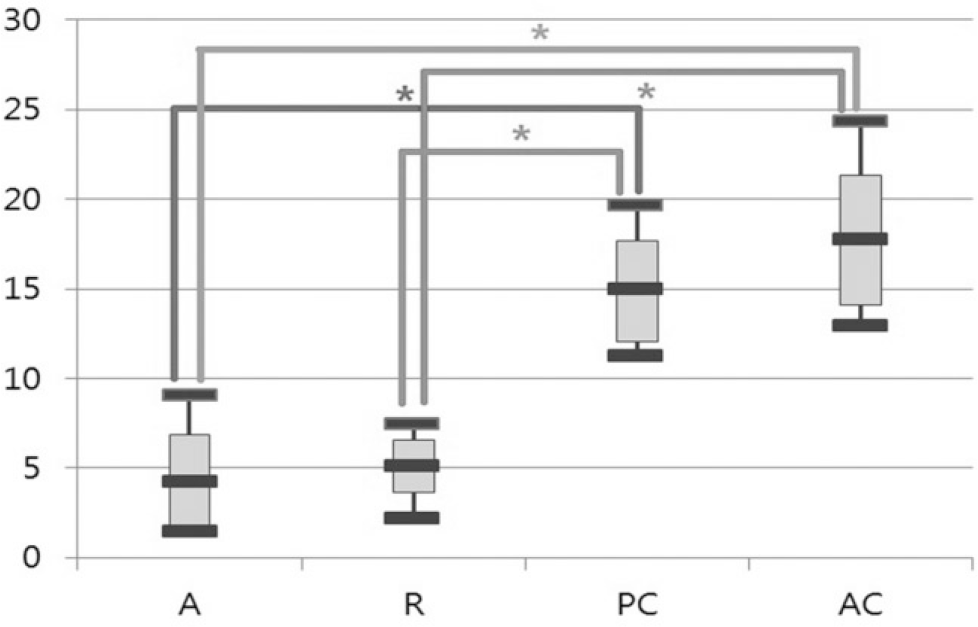 | Fig. 4.Shear-bond strength after thermocycling. The bars represent the SDs. ∗ indicates significant difference (P<.05). |
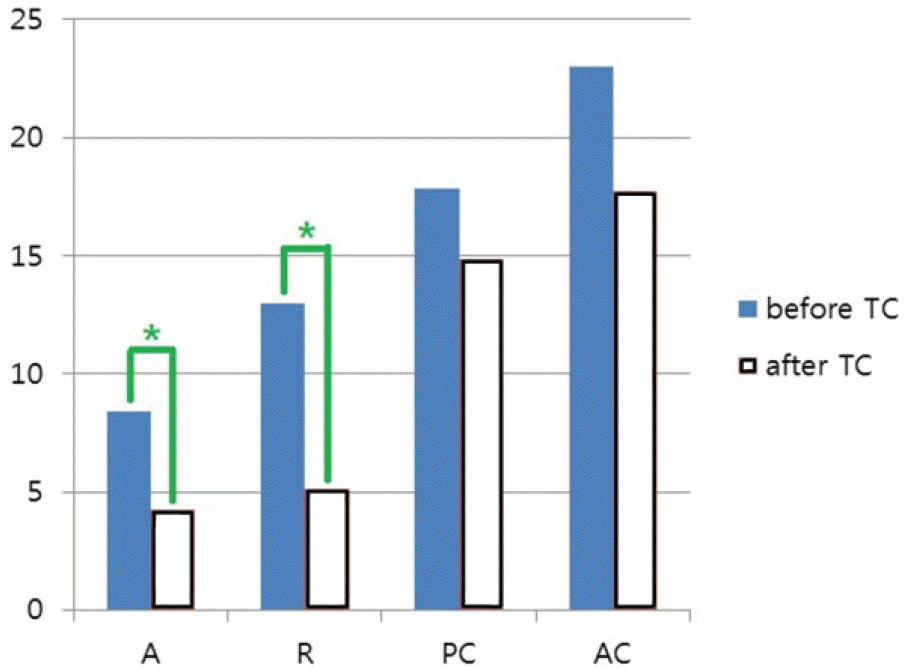 | Fig. 5.Influence of thermocycling on changes in shear bond strength of each group. ∗ indicates significant difference (P<.05). |
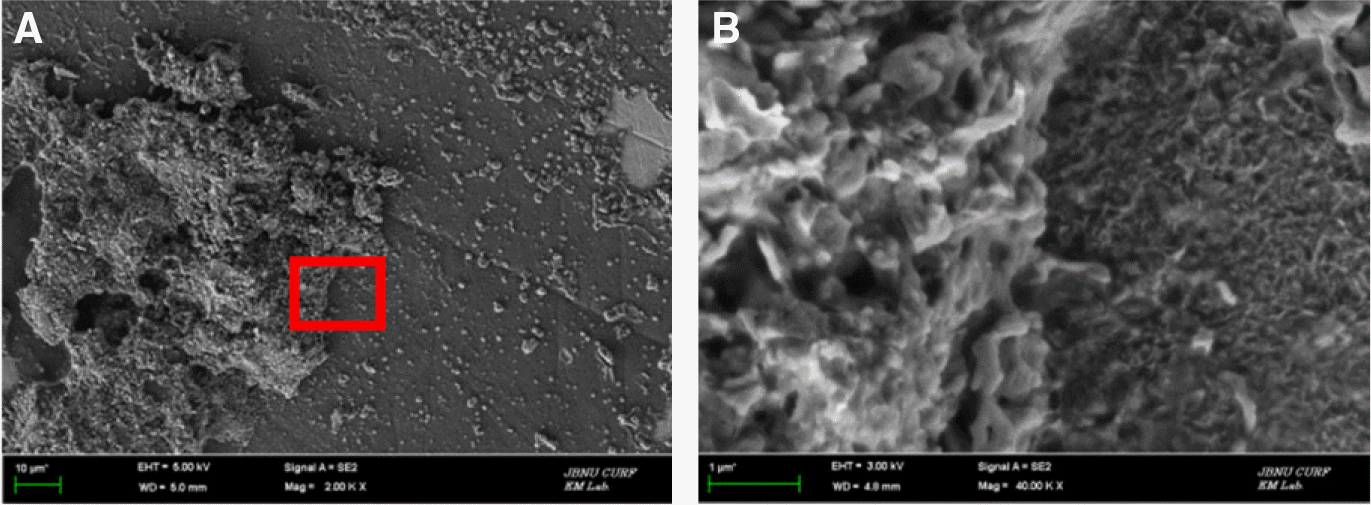 | Fig. 8.(A) FE-SEM image (×5,000) demonstrating cohesive failure mode of PC group, (B) FE-SEM image (×40,000) demonstrating high magnification of box in Fig. 8A. |
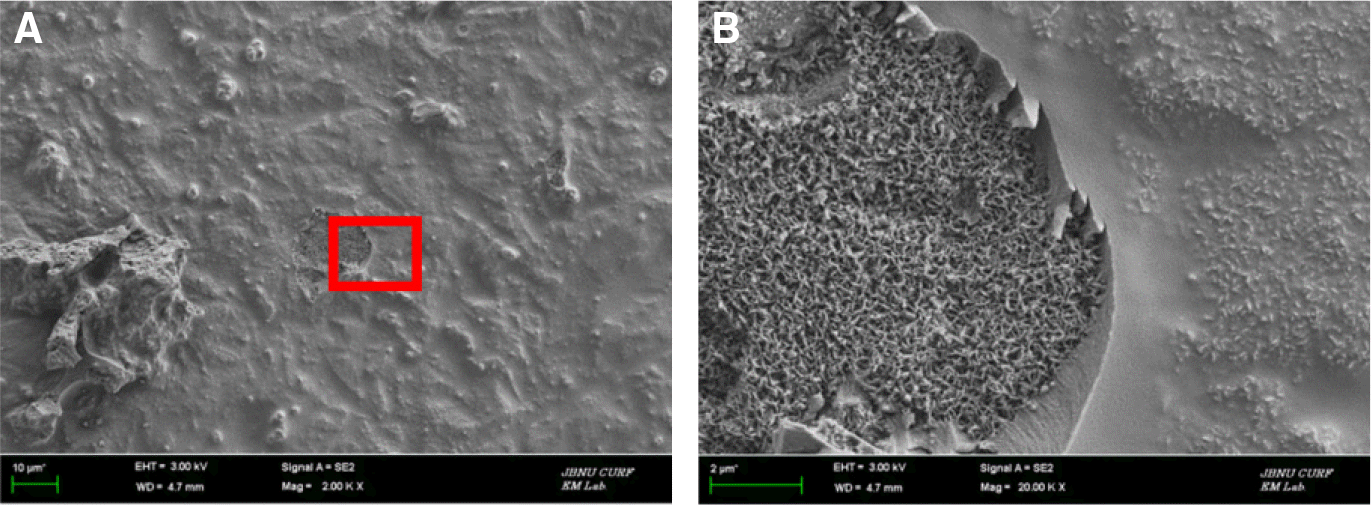 | Fig. 9.(A) FE-SEM image (×2,000) demonstrating cohesive failure mode of AC group, (B) FE-SEM image (×20,000) demonstrating high magnification of box in Fig. 9A. |
Table 1.
Classification of groups depending on surface treatments
Table 2.
Results of two-way ANOVA
Table 3.
Shear-bond strength in MPa of composite resin cement (RelyX Unicem) to Y-TZP ceramic after different types of surface-conditioning




 PDF
PDF ePub
ePub Citation
Citation Print
Print


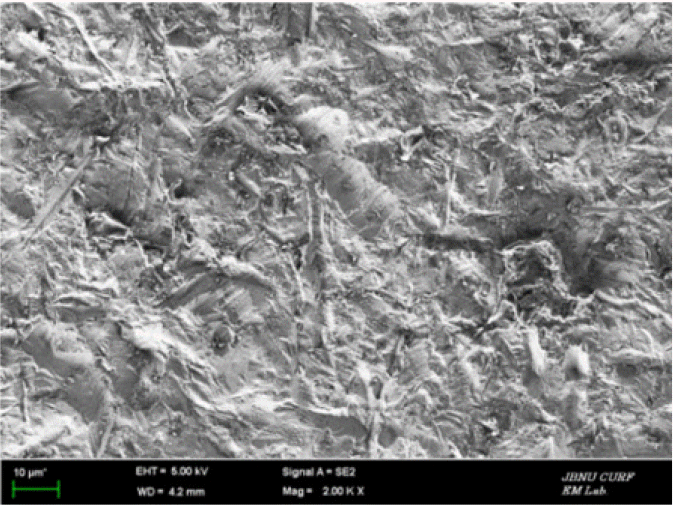
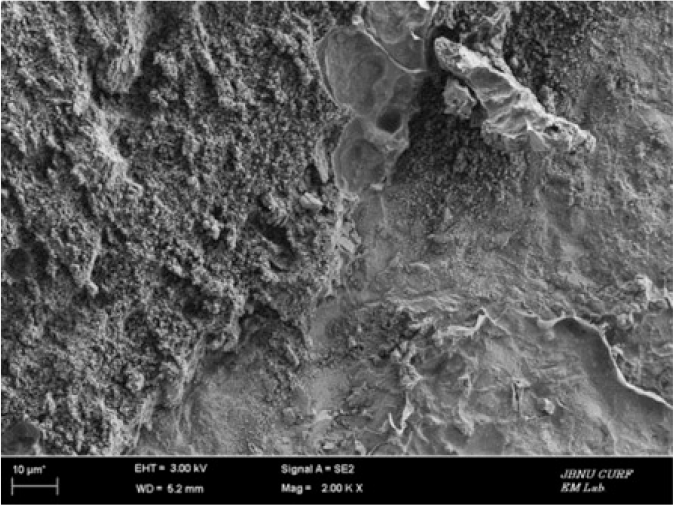
 XML Download
XML Download